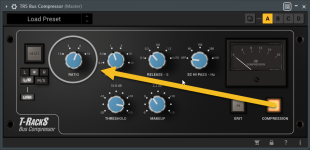Almost any digital or analog audio compressor has a parameter labeled ratio and this allows a beatmaker, a mixing or an audio mastering engineer to set the amount of compression that takes place when an audio signal goes past the "threshold level" of the compressor.
For example, a compression ratio of 4:1 means for every 4 dB the audio signal exceeds the compressor's threshold only, 1 dB of that audio material is let through — the rest is attenuated via gain-reduction (compression).
High ratio settings will result in heavy compression hence there is a positive correlation and vice-versa.
For example, a ratio of 10:1 is widely considered the starting point of limiting while compression ratios like 2:1, 3:1, and 4:1 are often referred to as gentle compression in the context of mixing music.
In the context of audio mastering compression ratios of 1.2, 1.5, and 1.7 are more ideal depending on the needs of the program material in question. Sometimes compression may not be suitable and therefore completely bypassed. However, this is a matter of subjective taste.
For example, a compression ratio of 4:1 means for every 4 dB the audio signal exceeds the compressor's threshold only, 1 dB of that audio material is let through — the rest is attenuated via gain-reduction (compression).
High ratio settings will result in heavy compression hence there is a positive correlation and vice-versa.
For example, a ratio of 10:1 is widely considered the starting point of limiting while compression ratios like 2:1, 3:1, and 4:1 are often referred to as gentle compression in the context of mixing music.
In the context of audio mastering compression ratios of 1.2, 1.5, and 1.7 are more ideal depending on the needs of the program material in question. Sometimes compression may not be suitable and therefore completely bypassed. However, this is a matter of subjective taste.


